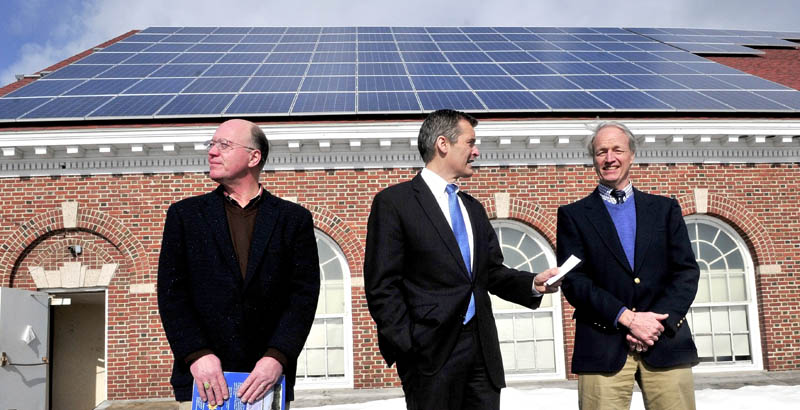FAIRFIELD — A magnet high school that teaches students about living in productive harmony with the environment is modeling how to do just that.
On a frigid, blustery Monday, school officials at the Maine Academy of Natural Sciences unveiled a $125,000 solar project atop the south-facing roof of Prescott Memorial, which houses administrative offices, the cafeteria and an auditorium.
“We’re demonstrating to our kids what our future will look like” in terms of being responsible citizens, Cummings said during a press conference while potential students interested in sustainability, agriculture, forestry and environmental studies toured the campus.
School officials are also modeling how to form beneficial partnerships.
Cummings, executive director of the academy and its parent, Good Will-Hinckley, announced the school had forged a unique partnership with ReVision Energy, a solar energy installation company based in Liberty.
ReVision Energy and the academy have a power purchase agreement — Revision Energy built, owns and operates the solar system and the academy buys the power generated by the system.
The school has been buying the power since January and Cummings said it’s already saving the school money.
It is projected the 110 solar panels, each measuring 3.5 feet by 5.5 feet, on the roof of the 1915 structure will save the academy more than $5,000 annually.
Cummings said every cent saved would go toward scholarships for students.
After six years, Good Will-Hinckley has the option to buy the solar system for $30,000 or continue to buy the power from ReVision.
ReVision co-founder Bill Behrens said the power purchase agreement “allows nonprofits, educational systems and municipalities to reap the benefits of solar energy without the upfront costs to install the system.”
Behrens said he expected ReVision Energy, which will receive federal tax incentives that nonprofit organizations like the school are not eligible for, might break even with the agreement.
“It’s our philanthropic contribution to sustainability in Maine,” he said.
Behrens said renewable energy is the long-term solution to the energy crisis and that it’s especially important to help schools, towns and nonprofit organizations address their energy costs. He said the solar panels can last 50 years and don’t need maintenance or cleaning.
In addition to the financial savings, Cummings said solar power is also better for the environment than burning oil and other fuel.
ReVision Energy estimated the 25.85-kilowatt solar system at Hinckley would annually produce 34,000 kilowatts of energy — about 10 percent of what the academy uses — and would annually eliminate about 50,000 pounds of carbon dioxide pollutants from the atmosphere.
And he said the installation provided jobs.
ReVision Energy started nine years ago with three employees; today it has 45.
If the school is not using all the energy captured by the solar panels, the power returns to the Central Maine Power grid, and the school receives financial credit.
Behrens and Cummings said the third partner in the project — Coastal Enterprises Inc. — made the project financially viable. The Wiscasset-based nonprofit community development financial institution provided start-up money for the $125,000 project, which ReVision will pay back over time.
Steve Cole, director of Natural Resources and Sustainable Communities at Coastal Enterprises Inc., said the company was proud to have helped get the project off the ground. “This project will save Good Will-Hinckley a significant amount of money while revolutionizing the way they power the campus,” he said.
And the solar installation on the roof of Prescott Memorial, tucked in behind the clock and observation tower, may not be the last on the Good Will-Hinckley campus, which was a residential school until it closed for financial reasons in 2009. The magnet school opened in September.
Cummings said other academy buildings have south-facing roofs, including L.C. Bates Museum and Moody School, and are good candidates for solar panels.
Cummings said the Rev. George Walter Hinckley, who founded Good Will Farm in 1898 as a home for boys in need, “had an eye for solar energy.”
Cummings joked that if tennis does not prove popular at the first-year academy where students grow crops, cook, tap maple trees, make wreaths, recycle, compost, and create trails, then ground-mounted solar structures could be installed on the courts as well.
Enough panels could be mounted between the lines to supply energy for 40 percent of the campus, he said.
Beth Staples — 861-9252
bstaples@centralmaine.com
Send questions/comments to the editors.



Success. Please wait for the page to reload. If the page does not reload within 5 seconds, please refresh the page.
Enter your email and password to access comments.
Hi, to comment on stories you must . This profile is in addition to your subscription and website login.
Already have a commenting profile? .
Invalid username/password.
Please check your email to confirm and complete your registration.
Only subscribers are eligible to post comments. Please subscribe or login first for digital access. Here’s why.
Use the form below to reset your password. When you've submitted your account email, we will send an email with a reset code.